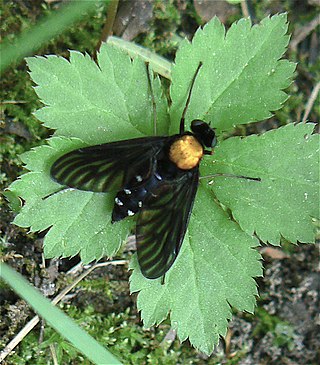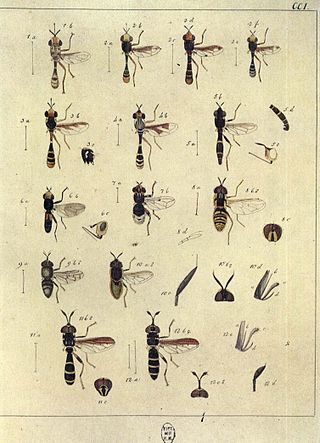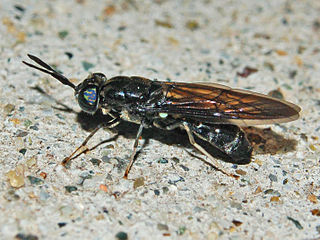
The subfamily Microdontinae contains slightly more than 400 species of hoverflies and, while diverse, these species share several characteristics by which they differ from other syrphids. The Microdontinae are myrmecophiles, meaning they live in the nests of ants. Larval Microdontinae are scavengers or predators in ant nests, and, in contrast to other syrphid larvae, have no readily apparent body segmentation. Some species also do not exhibit the typical adult flower-visiting behaviour of other hoverflies, but instead remain near their larval host colonies.

Chrysopilus is common, worldwide genus of predatory snipe flies. There are approximately 300 species in the genus, including fossil members that are sometimes found in amber.

Hover flies of the genus Microdon are unusual among the Diptera. Like other members of the subfamily, they are myrmecophiles, meaning they inhabit the nests of ants.

Syritta is a genus of hoverflies, family Syrphidae.

Xylota is a Holarctic genus of hoverflies similar in structure to the related genera Chalcosyrphus and Brachypalpoides. As the larvae are saprophytic they're usually found in rotting wood. The adult flies are generally associated with woodland and woodland edges and can often be seen running over the upper sides of leaves. Unlike other syrphids the adults of many species rarely visit flowers preferring instead to gather pollen from leaf surfaces. There are over 100 described species of which 12 can be found in Europe. Seven species have been recorded in Britain. Identification of species has been difficult and identifiction by photographs is risky.

Melanostoma is a large genus of hoverflies. Little is known of their biology, but they are suspected to be general predators of small insects in leaf litter.

Criorhina is a genus of hoverflies. Medium to large sized species, black or greenish black, with or without light ground markings mimicking bumblebees. The head is much flattened and broader than the thorax. The antennae are situated upon a prominent conical frontal process, The face is moderately produced below the eyes, downward or forward, in profile. The eyes are bare. The abdomen is elliptical or very short oval. Larvae found in rot holes or decaying hardwoods

Chalcosyrphus is a genus of hoverflies in the subfamily Eristalinae. Many species exhibit some degree of mimicry of various sawflies and other hymenopterans and are often brightly coloured or metallic in hue. The adults are similar in structure and behavior to the related genus Xylota but differ in larval morphology. They can be found throughout Europe, Asia, and North America and seem to prefer damper, boggy habitats. The larvae are saproxylic feeders in rotten wood in these habitats.
Archimicrodon is a genus of hoverflies. Many of the species in this genus were moved from Microdon by Reemer & Ståhls (2013). Previously, it had been described as having three known species.

Monoceromyia is a genus of hoverfly. Species in the genus are found in the Afrotropical, Australasian, Neotropical and Oriental regions. They are mimics of wasps and the genus is distinguished by the metapleura being widely separate behind the hind coxae. The elongated frontal base of the antenna is at least as long as the basal segment of the antenna and the second abdominal tergum is longer than wide and constricted.

Milesia is a genus of very large hoverflies, which mimic social wasps. For example, the European species Milesia crabroniformis is a convincing mimic of the hornet species Vespa crabro. Milesia are predominantly Palaeotropical in distribution almost entirely Oriental.

Sphiximorpha is a genus of hoverfly.

Ocyptamus is a large and diverse genus of over 200 species of hoverfly mostly found in the Neotropical region. It is likely that many of these species will be discovered to be synonyms though many others await description.

Hermetia is a genus of flies of the family Stratiomyidae.
Metadon is a genus of hoverfly containing 43 species. Most of the species were originally described in the genus Microdon.
Suragina is a genus of flies in the family Athericidae.












